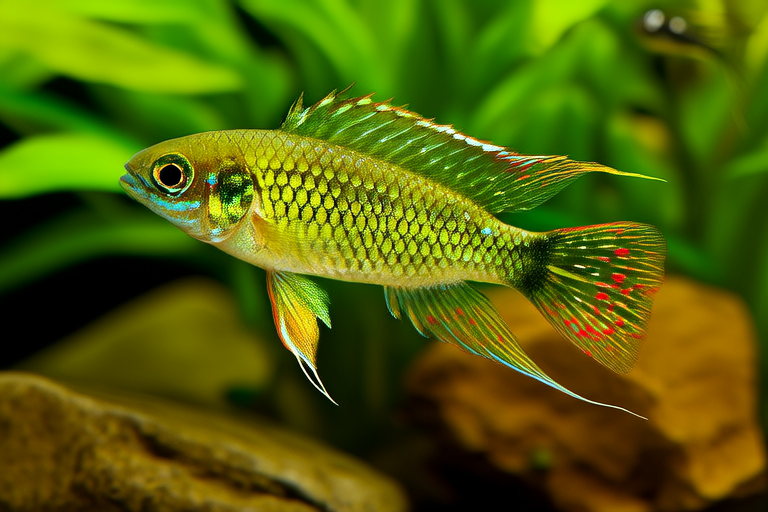Rajah Cichlid Care Made Easy: Tips from Expert Aquarists
Welcome to the world of Rajah cichlids! Known for their vibrant colors and interesting behavior, these freshwater fish are a favorite among aquarists. However, they require specific care to thrive. This guide will cover everything you need to know about keeping Rajah cichlids, from tank setup to breeding and health maintenance.
Understanding Rajah Cichlids
The Rajah cichlid (Apistogramma regani) is a small, colorful cichlid native to the Amazon River basin in South America. These fish are popular for their striking appearance, which includes bright red and yellow hues. They are territorial and can be aggressive, especially during breeding, but their beauty and unique behaviors make them a rewarding addition to any aquarium.
Ideal Tank Setup
Creating the right environment is crucial for the well-being of your Rajah cichlids. Here are some expert tips:
- Tank Size: A minimum of 30 gallons is recommended for a pair or trio of Rajah cichlids. Larger tanks allow for more swimming space and reduce stress.
- Substrate: Use fine sand or small gravel to mimic their natural habitat. Avoid sharp-edged substrates that could injure the fish.
- Decorations: Provide plenty of hiding spots with caves, driftwood, and plants. Java moss and java fern are good choices as they also serve as breeding sites.
- Filtration: Ensure adequate filtration to maintain water quality. A gentle filter is preferred to avoid strong currents.
- Heating: Maintain a temperature between 78-82°F (25-28°C). Use a reliable heater and monitor the temperature regularly.
- Lighting: Provide moderate lighting to encourage plant growth and simulate natural day-night cycles.
Water Parameters
Water conditions play a vital role in the health of Rajah cichlids. Here are the optimal parameters:
- pH Level: Aim for a pH between 6.0 and 7.0, slightly acidic. Test the water regularly to ensure stability.
- Hardness: Soft water is best, with a general hardness (GH) of 2-8 dGH. Use reverse osmosis or distilled water if necessary.
- Ammonia and Nitrite: Keep ammonia and nitrite levels at 0 ppm. Perform regular water changes to prevent buildup.
- Nitrate: Maintain nitrates below 20 ppm. Weekly partial water changes help control this parameter.
Regular testing and maintenance are key to providing a healthy environment for your Rajah cichlids.
Diet and Feeding
Rajah cichlids are omnivores and require a balanced diet to stay healthy. Experts recommend feeding them a variety of foods:
- High-Quality Pellets: Choose pellets designed for cichlids, which offer complete nutrition.
- Live and Frozen Foods: Offer brine shrimp, bloodworms, and daphnia for protein. These can be purchased frozen or live.
- Vegetables: Feed blanched vegetables like spinach, peas, and zucchini to provide fiber and nutrients.
- Frequency: Feed your Rajah cichlids twice daily, offering only what they can consume within a few minutes to prevent overfeeding.
Varying the diet ensures your fish receive all necessary nutrients and helps maintain their vibrant colors.
Breeding Habits
Rajah cichlids are prolific breeders, making them a joy to watch. To encourage breeding:
- Provide Hiding Spots: Ensure there are plenty of caves and dense vegetation where pairs can establish territories.
- Condition the Fish: Feed high-protein foods to condition the fish before breeding.
- Monitor Behavior: Look for signs of spawning readiness, such as digging in the substrate and pairing off.
- Brood Care: Once eggs are laid, the female will tend to them while the male guards the territory. Provide additional hiding spots to protect the fry.
- Fry Rearing: After hatching, feed newly hatched brine shrimp and microworms. Gradually introduce crushed flakes as they grow.
Patience and attention to detail are key when breeding Rajah cichlids.
Compatibility with Other Fish Species
Rajah cichlids can coexist with other fish, but careful selection is necessary:
- Aggressive Species: Avoid highly aggressive fish that might compete for resources or cause stress.
- Peaceful Species: Consider peaceful, bottom-dwelling species like Corydoras catfish or Otocinclus catfish. These fish can help keep the tank clean without interfering with cichlid territories.
- Same-Species: While Rajah cichlids can be kept in groups, it’s important to have a ratio of one male to several females to prevent aggression.
Research potential tankmates thoroughly to ensure a harmonious community.
Common Health Issues
Despite proper care, Rajah cichlids may face health challenges:
- Ich: Caused by parasites, ich appears as white spots on the fish. Treat with aquarium-safe medications.
- Fungal Infections: Fungus often grows on injured areas. Improve water quality and treat with antifungal remedies.
- Fin Rot: Bacterial infections can lead to fin rot. Maintain pristine water conditions and use antibiotics if necessary.
- Stress: High stress levels can weaken the immune system. Ensure a suitable environment and avoid overcrowding.
Early detection and prompt treatment are essential for successful recovery.
Expert Advice and Practical Tips
Expert aquarists share their wisdom:
“Always observe your fish closely. Changes in behavior or appearance can indicate underlying issues.” – Dr. Sarah Thompson, Marine Biologist
Additional tips:
- Use a quarantine tank for new additions to prevent introducing diseases.
- Perform regular water changes and maintain stable water parameters.
- Invest in a quality water testing kit to monitor water quality.
- Provide a varied diet to support overall health.
- Be patient and observant. Each fish has its own personality and care needs.
By following these guidelines, you’ll create a thriving environment for your Rajah cichlids.
Conclusion
Caring for Rajah cichlids is both challenging and rewarding. With the right tank setup, proper diet, and attentive monitoring, you can enjoy these beautiful fish for years to come. Remember, each fish is unique, so adapt your care practices based on individual needs. Happy fishkeeping!
